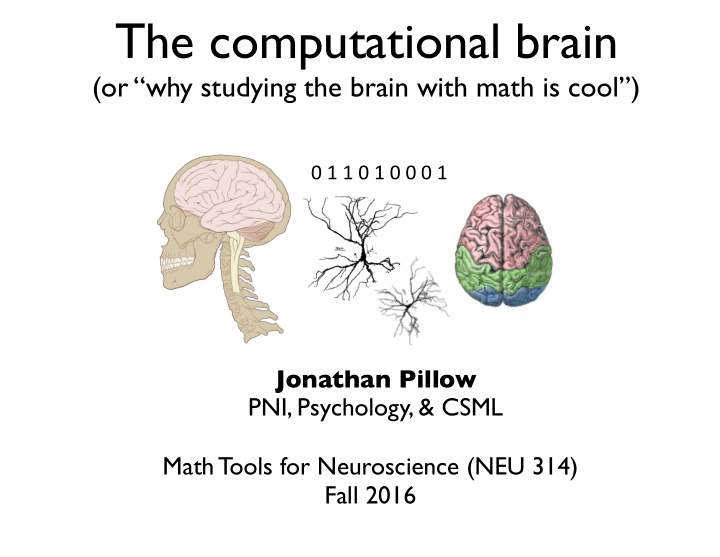



The computational brain (or “why studying the brain with math is cool”) +&'&'&+&'&+&+&+&'& Jonathan Pillow PNI, Psychology, & CSML Math Tools for Neuroscience (NEU 314) Fall 2016
What is computational neuroscience? 1. Use of mathematical/computational tools to study the brain. • Estimate biological properties from noisy data • build models that replicate behavior of neurons 2. Study how the brain behaves as a computer • Brain is a machine for processing information & computing relevant outputs • What algorithms / routines does it use?
Mind-Brain Problem What is the relationship of the mind to the brain?
The brain as a computer: “The brain computes! This is accepted as a truism by the majority of neuroscientists engaged in discovering the principles employed in the design and operation of nervous systems. What is meant here is that any brain takes the incoming sensory data, encodes them into various biophysical variables, such as the membrane potential or neuronal firing rates, and subsequently performs a very large number of ill-specified operations, frequently termed computations, on these variables to extract relevant features from the input. The outcome of some of these computations can be stored for later access and will, ultimately, control the motor output of the animal in appropriate ways.” - Christof Koch, Biophysics of Computation
Short history of brain metaphors: • hydraulic device (Descartes, 17th C.) • mill (Leibniz, 17 th C.) • telegraph (Sherrington, early 20 th C.) • telephone switchboard (20 th C.) • digital computer (late 20th C.) • quantum computer? (Penrose, 1989) • convolutional neural network? (21st C.)
What does it mean to claim the brain is a computer? Sensory Motor Brain Input Output • The physical parts of the brain are important only insofar as they represent steps in a formal calculation. • Any physical device implementing the same formal system would have the same “mind properties” as a brain.
What does it mean to claim the brain is a computer? Sensory Motor Brain Input Output Claim : Most neuroscientists take it for granted that the brain is a computer. They are devoted to finding out which computer (i.e., what formal structure? what algorithms does the brain implement?).
What is (some of) the evidence that the brain is a computer?
Mathematical model of sensory neurons the retina detect light photoreceptors bipolar cells output cells retinal ganglion cells (send all visual information to the brain) to brain!
Mathematical model of sensory neurons the retina photoreceptors what mathematical operation? bipolar cells Difference of light in “center” - + - and light in the “surround” retinal ganglion cells
Mathematical model of sensory neurons stimulus photoreceptors bipolar cells Difference of light in “center” - + - and light in the “surround” retinal ganglion cells lots of spikes!
Mathematical model of sensory neurons stimulus photoreceptors bipolar cells Difference of light in “center” - + - and light in the “surround” retinal ganglion cells few spikes
Mathematical model of sensory neurons stimulus photoreceptors bipolar cells Difference of light in “center” - + - and light in the “surround” retinal ganglion cells more spikes
Mach Bands Each stripe has constant luminance Then why does it look like there’s a gradient?
Mach Bands Each stripe has constant luminance Cell on left - + - Cell on right - + - edge edge Then why does it look like there’s a gradient?
The Neural Coding Problem “encoding function” spikes stimulus • How does the brain take stimuli and “code” them with sequences of spikes?
Lightness Illusion
Hermann illusion
This magical slide can track where you’re looking
Color Computations Beau Lotto
Color Computations Beau Lotto
color after-images • neurons adjust their response properties after prolonged exposure to an image • we can compute (and predict) these changes! • red —> green after-image • blue —> yellow after-image • black —> white after-image
Neural prostheses: Neurons can be replaced by other entities (silicon chips) that have different physical structure but carry out the same (or similar) mathematical operations, allowing the organism to produce (“compute”) the same behavior.
Cochlear implants (using a “different computer” to encode auditory signals) transmitter receiver cochlea n i a r b o t microphone electrode array
Interchangeability : replacing neurons with silicon Sensory Motor Brain Input Output If we understand the mathematical operations carried out by different parts of the brain, we could (in theory) replace them with new parts that perform the same computations!
There are about 10 billion cubes of this size in your brain! 10 microns
And this is a great time to study neuroscience. Why? • We are about to get incredible data. • Computers are getting extremely fast. • Advances in statistical/mathematical techniques are allowing us to gain a deep understanding of neural data and neural information processing capabilities
some of the kinds of math involved • linear algebra • probability & statistics • dynamical systems / differential equations (including chaos theory) • signal processing • information theory / coding theory
Recommend
More recommend